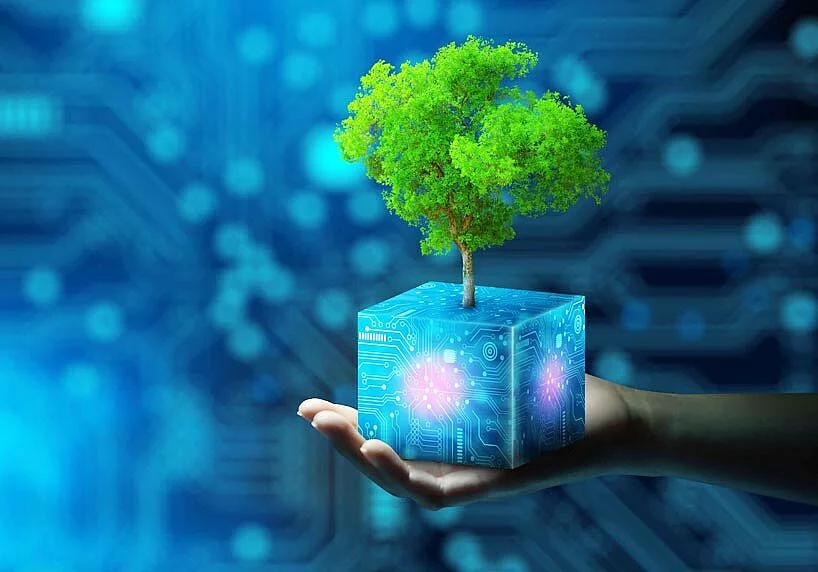Technology plays a central role in shaping business success and innovation. However, as the demand for digital solutions continues to rise, the environmental impact of technology has become a growing concern. The tech industry’s carbon footprint is significantly high, including energy consumption of data centers and the mounting problem of electronic waste (e-waste),
Simultaneously, there is an emerging opportunity to address these challenges through Green IT—a set of practices that focus on environmentally responsible technology use, from hardware to software. Green IT is an evolving movement that aligns technological innovation with sustainability goals.
What is Green IT?
Green IT, also known as sustainable IT, refers to the design, development, and management of technology with the goal of reducing its environmental impact. This can involve anything from optimizing energy use in data centers to promoting the recycling of electronic devices and reducing the carbon emissions associated with the technology we use.
As businesses and consumers become more conscious of environmental sustainability, adopting Green IT practices has shifted from being a “nice-to-have” to a “must-have” for organizations looking to align their operations with global sustainability goals.
Key Components of Green IT
Let’s take a look at some of the key ways that Green IT is being implemented in the tech industry, and how businesses can leverage these practices to not only reduce their environmental impact but also improve efficiency and cut costs.
1️. Energy-Efficient Infrastructure
Data centers, the backbone of the internet, consume a large amount of electricity to run servers and maintain operations. Traditionally, these facilities have been energy-intensive, but the rise of energy-efficient technologies has revolutionized how businesses can manage their data storage and processing needs.
Virtualization is one of the primary techniques used to reduce energy consumption. By running multiple virtual machines on a single physical server, businesses can maximize server utilization and reduce the need for additional hardware. Cloud computing also plays a crucial role here by allowing businesses to outsource infrastructure to providers with more energy-efficient, sustainable data centers. These solutions not only help businesses reduce their carbon footprint but also lower operational costs.
2️. Minimizing E-Waste
Electronic waste, or e-waste, has become one of the fastest-growing environmental challenges worldwide. The rapid pace of technological innovation leads to frequent upgrades, and many devices are discarded long before the end of their useful life. This contributes to the buildup of harmful chemicals and plastics in landfills.
A key aspect of Green IT is extending the lifespan of devices and promoting their responsible disposal. Practices such as hardware recycling, refurbishing older devices, and repairing rather than replacing can significantly reduce e-waste. Additionally, many companies are adopting circular economy principles, where materials are continuously reused, reducing the demand for raw materials and minimizing waste. Encouraging these practices within organizations not only benefits the environment but can also result in cost savings.
3️. Cloud Computing and Virtualization
Cloud computing is another Green IT innovation that has transformed how businesses manage their IT infrastructure. Unlike traditional on-site data storage, cloud services allow companies to centralize their data processing in efficient data centers that can be shared across multiple organizations. This sharing of resources helps to reduce the total amount of infrastructure needed, leading to energy savings.
Virtualization technology, which allows multiple systems to run on a single physical server, is commonly used in cloud environments to further improve energy efficiency. With these technologies, businesses can reduce the physical hardware they use, which cuts down on energy consumption and e-waste, while simultaneously improving scalability and flexibility.
4️. Sustainable Software Development
Sustainable software development is also a crucial aspect of Green IT. Sustainable software development focuses on optimizing code to improve efficiency and reduce the energy consumption of applications. Writing optimized code that uses fewer resources, reduces processing time, and minimizes the power required by end-user devices are all important components of a sustainable software strategy.
As more applications move to the cloud, there is a growing emphasis on green coding practices that ensure software is not only functional but also energy-efficient. This means fewer server requests, more efficient data processing, and better resource management—all of which contribute to a smaller carbon footprint.
Why Green IT Matters for Businesses
There are several reasons why adopting Green IT is becoming essential for businesses:
- Cost Savings: Reducing energy consumption, optimizing infrastructure, and extending the life of devices can lead to substantial savings in operational costs. Additionally, energy-efficient technologies often offer better performance at lower costs over time.
- Reputation and Market Demand: Consumers and businesses alike are becoming more eco-conscious. Companies that adopt sustainable practices can improve their reputation and appeal to a growing segment of environmentally aware customers.
- Compliance with Regulations: Governments worldwide are increasing regulations on sustainability. By adopting Green IT, businesses can ensure they are compliant with environmental regulations and avoid penalties.
- Future-Proofing: As technology continues to evolve, sustainability will be a key factor in maintaining competitiveness. Businesses that embrace Green IT today are positioning themselves to thrive in a future where eco-consciousness becomes a standard.
The Future of Green IT
The future of IT is undeniably green. With growing concerns about climate change, e-waste, and resource depletion, the demand for sustainable technologies will continue to rise. Cloud services, energy-efficient infrastructure, circular economy principles, and sustainable software development are just the beginning of what’s possible.
As technology continues to evolve, businesses have the opportunity to not only improve their operational efficiency and performance but also contribute to a more sustainable world. By embracing Green IT, companies are making a long-term investment in both their success and the planet’s future.




